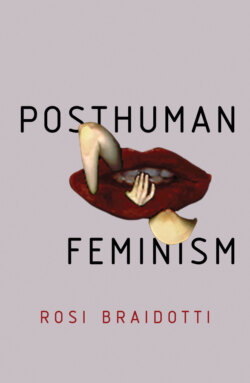Читать книгу Posthuman Feminism - Rosi Braidotti - Страница 12
The Man of Reason as the Image of Humanism
ОглавлениеHumanism has helped construct liberal democracies by upholding the separation of Church from State and instigating fundamental freedom under the rule of law. From the Enlightenment, humanism took its emancipatory belief in the universal powers of scientific reason and faith in technological progress, as well as adjacent values such as secular tolerance and equality for all. As such, humanism supports the Western project of modernity, including its industrial, imperialist and bellicose inclinations (Davies, 1997).
The main version of humanism that plays out in the posthuman convergence is a retake on the European renaissance ideal of the human as ‘the measure of all things’ or the ‘Man of Reason’ (Lloyd, 1984). This European humanist ideal positions the universalizing powers of a sovereign notion of reason as the basic unit of reference to define what counts as human. This hegemonic idea of ‘Man’ as coinciding with universal reason also claims exclusive rights to self-regulating rational judgement, moral self-improvement and enlightened governance for European subjects. That image was represented visually by Leonardo in the famous sketch of the Vetruvian body as the perfectly proportioned, healthy, male and white model, which became the golden mean for classical aesthetics and architecture (Braidotti, 2013). The human thus defined is not so much a species as a marker of European culture and society and for the scientific and technological activities it privileges.
The humanist values and their rationalist underpinnings apply both to individuals and to groups operating within scientific and moral criteria of human perfectibility. They thus act as the motor of human evolution coinciding with the teleological progress of human civilization (intrinsically assumed to be European) through science and technology. The ‘Man’ of classical humanism was positioned at the pinnacle of an evolutionary scale, which classified different classes of beings lower down the hierarchical ranks and files. They are the ‘others’ defined as the negative opposites of the dominant human norm.1 The point here is that difference, being ‘other than’ or ‘different from’ ‘Man’, is actually negatively perceived as ‘worth less than’ ‘Man’. This epistemic and symbolic exclusion is no abstraction: it translates into ruthless violence for the real-life people who happen to coincide with categories of negative difference. They are the women and LGBTQ+ people (sexualized others), Black and Indigenous people (racialized others) and the animals, plants and earth entities (naturalized others). Their social and symbolic existence was denied, leaving them disposable and unprotected. They are multiple and disqualified, whereas ‘Man’ is One and fully entitled.
The power of ‘Man’ as a hegemonic civilizational model was instrumental to the project of Western modernity and the colonial ideology of European expansion. ‘White Man’s burden’ as a tool of imperialist and patriarchal governance assumed that Europe is not just a geo-political location, but rather a universal attribute of human consciousness that can transfer its quality to any suitable subjects, provided they comply with the required discipline. Europe as superior universal consciousness posits the power of reason as its distinctive characteristic and humanistic universalism as its particularity. It encloses an allegedly universal notion of reason within ‘the snowy masculinist precincts of European philosophy’ and its relentless pursuit of gaining material access to real-life others (Weheliye, 2014: 47).
Controlled by white, European, heterosexual, property-owning, male, legal citizens, mainstream humanistic culture upholds dominant memory and selects who gets to write official history. It functions as a centralized databank that edits out and de-selects the existence, activities, practices as well as the alternative or subjugated memories of the multiple sexualized and racialized minorities (Wynter, 2015). Think, for instance, of the extent to which European mythologies, National Art Galleries, Science and Natural History museums are filled with signs and traces of the subjugation of women, Black and Indigenous people, animal and earth others (Ang, 2019). Their representations are overdetermined and depicted as necessarily absent, excluded from the centre stage. These multitudes of others are as plentiful as they are nameless: so many Indigenous people, Orientalized women, exotic birds, captive Africans, devious mermaids and scary monsters of all denominations abound, but there is only ever one ‘Man’. In the Odyssey, the archetypical figure of Odysseus goes by the name of ‘Nobody’, representing all men and as such becoming the negative of ‘everybody’.2 Man, thus defined is the zero degree of otherness or deviation from the human standard he embodies and projects to normative heights. Like a blank that can be endlessly refilled, he who-shall-not-be-named is entitled to call all others by his name. The mythologized Man in the figure of Odysseus is the face of Anthropos in Western culture.
